
Sam Hallas' Website
The BT Museum Memorial Pages - Telegraphy Items
Wheatstone's ABC Telegraph
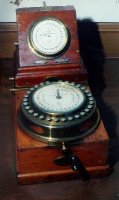 An example of de-skilling. Unlike Morse telegraphs, no knowledge of a code
was needed. The button next to the desired letter was held down and the
handle cranked. The needles of the instruments at both ends moved until
they pointed to the chosen letter. The foreground part of the instrument is the transmitter,
and the part at the back is the receiver.
An example of de-skilling. Unlike Morse telegraphs, no knowledge of a code
was needed. The button next to the desired letter was held down and the
handle cranked. The needles of the instruments at both ends moved until
they pointed to the chosen letter. The foreground part of the instrument is the transmitter,
and the part at the back is the receiver.
Wheatstone Stick Punch
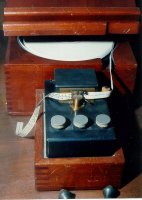 Wheatstone's first means of producing punched paper tape for high speed
Morse transmission. Paper tape feeds from the reel at the back through the
punch head. The operator supplies all the power by striking the buttons at
the front using the sticks whose tips are just visible in the foreground.
Wheatstone's first means of producing punched paper tape for high speed
Morse transmission. Paper tape feeds from the reel at the back through the
punch head. The operator supplies all the power by striking the buttons at
the front using the sticks whose tips are just visible in the foreground.
Pneumatic Punch
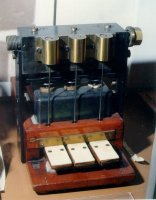 Wheatstone's original method of preparing punched Morse tape required the
operator to thump the keys very hard with a stick. This later development
used a pneumatic action to make only a light pressure on the keys necessary
to punch the tape. The three keys would produce a dot, a dash, or a space.
Wheatstone's original method of preparing punched Morse tape required the
operator to thump the keys very hard with a stick. This later development
used a pneumatic action to make only a light pressure on the keys necessary
to punch the tape. The three keys would produce a dot, a dash, or a space.
Morse Transmitter
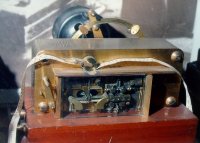 Messages prepared in advance on paper tape could be sent to line at much greater
speed than possible with a human operator. The tape was advanced by a series of
sprocket holes in the centre with larger holes either side signifying a dot or a
dash. A pair of "peckers" underneath felt at the holes and translated
them into the dots and dashes to line.
Messages prepared in advance on paper tape could be sent to line at much greater
speed than possible with a human operator. The tape was advanced by a series of
sprocket holes in the centre with larger holes either side signifying a dot or a
dash. A pair of "peckers" underneath felt at the holes and translated
them into the dots and dashes to line.
Morse Sounder
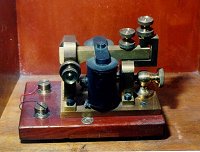 The black coils of the electromagnet attracted the steel pole piece, across the
top, pulling the pivotted brass lever down giving the characteristic click. The sound
was amplified by placing the sounder in a wooden case (in background)
The black coils of the electromagnet attracted the steel pole piece, across the
top, pulling the pivotted brass lever down giving the characteristic click. The sound
was amplified by placing the sounder in a wooden case (in background)
The Baudot Distributor
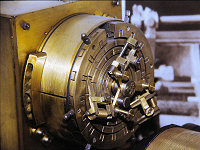 An early system of time-division multiplex. The operators' keyboards were
connected to a single telegraph circuit via the distributor. At the receving
end the receivers were connected through a similar distributor. By keeping
the commutators at both ends in synchronism the signal from one keyboard
was routed to its correspnding receiver. This Baudot distributor (now believed to be at Amberley) is more complete than the one in the Science Museum.
An early system of time-division multiplex. The operators' keyboards were
connected to a single telegraph circuit via the distributor. At the receving
end the receivers were connected through a similar distributor. By keeping
the commutators at both ends in synchronism the signal from one keyboard
was routed to its correspnding receiver. This Baudot distributor (now believed to be at Amberley) is more complete than the one in the Science Museum.
Baudot Keyboard
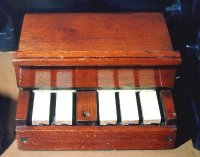 The operator had to memorise the five-unit code and press the keys at the
precise moment the commutator was connected. The operation is described
in the Short History of Telegraphy
The operator had to memorise the five-unit code and press the keys at the
precise moment the commutator was connected. The operation is described
in the Short History of Telegraphy
Exhibits: British Telecom Collection
Photos: copyright Sam Hallas 1992-1997
Telecomms Index
 An example of de-skilling. Unlike Morse telegraphs, no knowledge of a code
was needed. The button next to the desired letter was held down and the
handle cranked. The needles of the instruments at both ends moved until
they pointed to the chosen letter. The foreground part of the instrument is the transmitter,
and the part at the back is the receiver.
An example of de-skilling. Unlike Morse telegraphs, no knowledge of a code
was needed. The button next to the desired letter was held down and the
handle cranked. The needles of the instruments at both ends moved until
they pointed to the chosen letter. The foreground part of the instrument is the transmitter,
and the part at the back is the receiver.






 Back
Next
Back
Next
